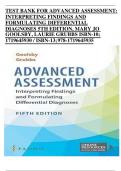TEST BANK FOR ADVANCED ASSESSMENT:
INTERPRETING FINDINGS AND
FORMULATING DIFFERENTIAL
DIAGNOSES 5TH EDITION, MARY JO
GOOLSBY, LAURIE GRUBBS ISBN-10;
1719645930 / ISBN-13; 978-1719645935
,Chapter k 1. k Assessment k and k Clinical k Decision-Making: k Overview
Multiple kChoice
Identify kthe kchoice kthat kbest kcompletes kthe kstatement kor kanswers kthe kquestion.
k 1. Which ktype kof kclinical kdecision-making kis kmost kreliable?
A. Intuitive
B. Analytical
C. Experiential
D. Augenblick
k 2. Which kof kthe kfollowing kis kfalse? kTo kobtain kadequate khistory, khealth-care kproviders kmust kbe:
A. Methodical kand ksystematic
B. Attentive kto kthe kpatient’s kverbal kand knonverbal klanguage
C. Able kto kaccurately kinterpret kthe kpatient’s kresponses
D. Adept kat kreading kinto kthe kpatient’s kstatements
k 3. Essential kparts kof ka khealth khistory kinclude kall kof kthe kfollowing kexcept:
A. Chief kcomplaint
B. History kof kthe kpresent killness
C. Current kvital ksigns
D. All kof kthe kabove kare kessential khistory kcomponents
k 4. Which kof kthe kfollowing kis kfalse? kWhile kperforming kthe kphysical kexamination, kthe kexaminer
kmust kbekable kto:
A. Differentiate kbetween knormal kand kabnormal kfindings
B. Recall kknowledge kof ka krange kof kconditions kand ktheir kassociated ksigns kand ksymptoms
C. Recognize khow kcertain kconditions kaffect kthe kresponse kto kother kconditions
D. Foresee kunpredictable kfindings
k 5. The kfollowing kis kthe kleast kreliable ksource kof kinformation kfor kdiagnostic kstatistics:
A. Evidence-based kinvestigations
B. Primary kreports kof kresearch
C. Estimation kbased kon ka kprovider’s kexperience
D. Published kmeta-analyses
k 6. The kfollowing kcan kbe kused kto kassist kin ksound kclinical kdecision-making:
A. Algorithm kpublished kin ka kpeer-reviewed kjournal karticle
B. Clinical kpractice kguidelines
C. Evidence-based kresearch
D. All kof kthe kabove
k 7. If ka kdiagnostic kstudy khas khigh ksensitivity, kthis kindicates ka:
A. High kpercentage kof kpersons kwith kthe kgiven kcondition kwill khave kan kabnormal kresult
B. Low kpercentage kof kpersons kwith kthe kgiven kcondition kwill khave kan kabnormal kresult
C. Low klikelihood kof knormal kresult kin kpersons kwithout ka kgiven kcondition
D. None kof kthe kabove
,k 8. If ka kdiagnostic kstudy khas khigh kspecificity, kthis kindicates ka:
A. Low kpercentage kof khealthy kindividuals kwill kshow ka knormal kresult
B. High kpercentage kof khealthy kindividuals kwill kshow ka knormal kresult
C. High kpercentage kof kindividuals kwith ka kdisorder kwill kshow ka knormal kresult
D. Low kpercentage kof kindividuals kwith ka kdisorder kwill kshow kan kabnormal kresult
k 9. A klikelihood kratio kabove k1 kindicates kthat ka kdiagnostic ktest kshowing ka:
A. Positive kresult kis kstrongly kassociated kwith kthe kdisease
B. Negative kresult kis kstrongly kassociated kwith kabsence kof kthe kdisease
C. Positive kresult kis kweakly kassociated kwith kthe kdisease
D. Negative kresult kis kweakly kassociated kwith kabsence kof kthe kdisease
k k k k 10. kWhich kof kthe kfollowing kclinical kreasoning ktools kis kdefined kas kevidence-based kresource
kbased kon kmathematical kmodeling kto kexpress kthe klikelihood kof ka kcondition kin kselect
ksituations, ksettings, kand/orkpatients?
A. Clinical kpractice kguideline
B. Clinical kdecision krule
C. Clinical kalgorithm
D. Clinical krecommendation
, Answer kSection
MULTIPLE kCHOICE
1. ANS: k B
Croskerry k(2009) kdescribes ktwo kmajor ktypes kof kclinical kdiagnostic kdecision-making:
kintuitive kand kanalytical. kIntuitive kdecision-making k(similar kto kAugenblink kdecision-making)
kis kbased kon kthe kexperience kand kintuition kof kthe kclinician kand kis kless kreliable kand kpaired
kwith kfairly kcommon kerrors. kIn kcontrast, kanalytical kdecision-making kis kbased kon kcareful
kconsideration kand khas kgreater kreliabilitykwith krare kerrors.
PTS: 1
2. ANS: k D
To kobtain kadequate khistory, kproviders kmust kbe kwell korganized, kattentive kto kthe kpatient’s
kverbal kandknonverbal klanguage, kand kable kto kaccurately kinterpret kthe kpatient’s kresponses kto
kquestions. kRather kthan kreading kinto kthe kpatient’s kstatements, kthey kclarify kany kareas kof
kuncertainty.
PTS: 1
3. ANS: k C
Vital ksigns kare kpart kof kthe kphysical kexamination kportion kof kpatient kassessment, knot kpart kof kthe
khealthkhistory.
PTS: 1
4. ANS: k D
While kperforming kthe kphysical kexamination, kthe kexaminer kmust kbe kable kto kdifferentiate
kbetweenknormal kand kabnormal kfindings, krecall kknowledge kof ka krange kof kconditions,
kincluding ktheir kassociated ksigns kand ksymptoms, krecognize khow kcertain kconditions kaffect kthe
kresponse kto kother kconditions, kand kdistinguish kthe krelevance kof kvaried kabnormal kfindings.
PTS: 1
5. ANS: k C
Sources kfor kdiagnostic kstatistics kinclude ktextbooks, kprimary kreports kof kresearch, kand
kpublished kmeta-analyses. kAnother ksource kof kstatistics, kthe kone kthat khas kbeen kmost kwidely
kused kand kavailable kfor kapplication kto kthe kreasoning kprocess, kis kthe kestimation kbased kon ka
kprovider’s kexperience, kalthough kthese kare krarely kaccurate. kOver kthe kpast kdecade, kthe
kavailability kof kevidence kon kwhich kto kbase kclinical kreasoning kis kimproving, kand kthere kis
kan kincreasing kexpectation kthat kclinical kreasoningkbe kbased kon kscientific kevidence.
kEvidence-based kstatistics kare kalso kincreasingly kbeing kused kto kdevelop kresources kto
kfacilitate kclinical kdecision-making.
PTS: 1
6. ANS: k D
To kassist kin kclinical kdecision-making, ka knumber kof kevidence-based kresources khave kbeen
kdevelopedkto kassist kthe kclinician. kResources, ksuch kas kalgorithms kand kclinical kpractice
kguidelines, kassist kin kclinical kreasoning kwhen kproperly kapplied.




